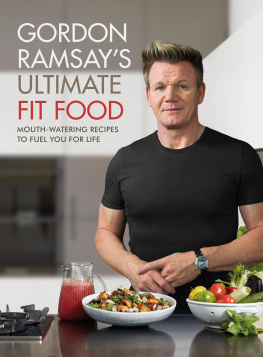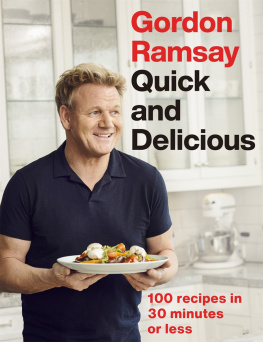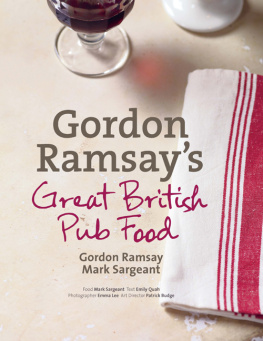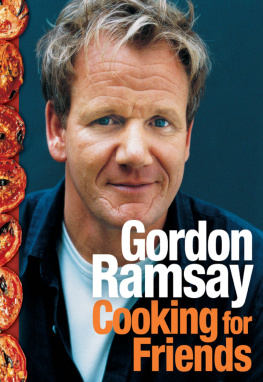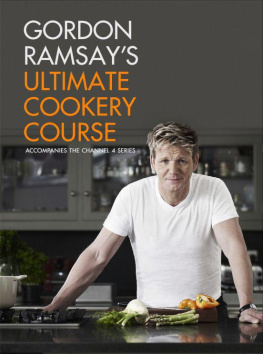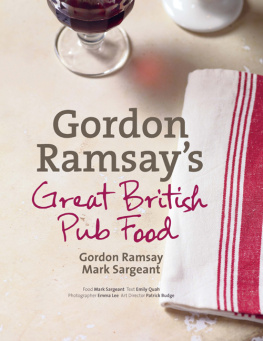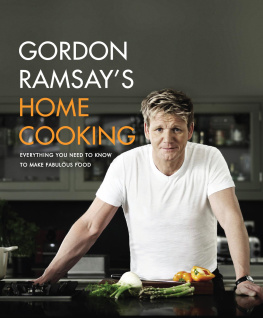Gordon Ramsay - Gordon Ramsay’s Ultimate Fit Food
Here you can read online Gordon Ramsay - Gordon Ramsay’s Ultimate Fit Food full text of the book (entire story) in english for free. Download pdf and epub, get meaning, cover and reviews about this ebook. year: 0, genre: Home and family. Description of the work, (preface) as well as reviews are available. Best literature library LitArk.com created for fans of good reading and offers a wide selection of genres:
Romance novel
Science fiction
Adventure
Detective
Science
History
Home and family
Prose
Art
Politics
Computer
Non-fiction
Religion
Business
Children
Humor
Choose a favorite category and find really read worthwhile books. Enjoy immersion in the world of imagination, feel the emotions of the characters or learn something new for yourself, make an fascinating discovery.
- Book:Gordon Ramsay’s Ultimate Fit Food
- Author:
- Genre:
- Year:0
- Rating:5 / 5
- Favourites:Add to favourites
- Your mark:
- 100
- 1
- 2
- 3
- 4
- 5
Gordon Ramsay’s Ultimate Fit Food: summary, description and annotation
We offer to read an annotation, description, summary or preface (depends on what the author of the book "Gordon Ramsay’s Ultimate Fit Food" wrote himself). If you haven't found the necessary information about the book — write in the comments, we will try to find it.
Gordon Ramsay’s Ultimate Fit Food — read online for free the complete book (whole text) full work
Below is the text of the book, divided by pages. System saving the place of the last page read, allows you to conveniently read the book "Gordon Ramsay’s Ultimate Fit Food" online for free, without having to search again every time where you left off. Put a bookmark, and you can go to the page where you finished reading at any time.
Font size:
Interval:
Bookmark:


www.hodder.co.uk

First published in Great Britain in 2018
by Hodder & Stoughton
An Hachette UK company
Copyright Gordon Ramsay 2018
Photography copyright Jamie Orlando Smith 2018
The right of Gordon Ramsay to be identified as the Author of the Work has been asserted by him in accordance with the Copyright, Designs and Patents Act 1988.
All rights reserved. No part of this publication may be reproduced, stored in a retrieval system, or transmitted, in any form or by any means without the prior written permission of the publisher, nor be otherwise circulated in any form of binding or cover other than that in which it is published and without a similar condition being imposed on the subsequent purchaser. A CIP catalogue record for this title is available from the British Library
ISBN 978 1 473 65228 6
Editorial Director: Nicky Ross
Project Editor: Natalie Bradley
Editor: Camilla Stoddart
Nutritionist: Kerry Torrens
Copy-editor: Annie Lee
Designer & Art Director: James Edgar
Photographer: Jamie Orlando Smith
Food Stylist: Phil Mundy
Props Stylist: Olivia Wardle
Shoot Producer: Ruth Ferrier
Art Director: Alasdair Oliver
Production Manager: Claudette Morris
Hodder & Stoughton Ltd
Carmelite House
50 Victoria Embankment
London EC4Y 0DZ
www.hodder.co.uk

I HAVE ALWAYS SAID THAT CHEFS EAT THE BEST FOOD AND THE WORST IN EQUAL MEASURE.
They work with the freshest, most delicious ingredients available, cook them perfectly and are constantly trying little tasty mouthfuls as they work. But do they get home and make themselves a nutritious meal at the end of their 16-hour shift? Im afraid they do not. The punishing working life of a chef means that they often rely on junk food and sugary snacks to get through the day, and finding time for exercise is really hard. When I was working in the restaurant at Royal Hospital Road, I never left the kitchen, sending everyone else out on their break rather than getting out myself, and I was snacking on the wrong things throughout the day. Over time, I let myself get out of shape. My chefs whites got tighter and tighter and I felt lethargic and sluggish a lot of the time.
It all changed when I started forcing myself to go to the gym for a run. I had to schedule it in like a trip to the dentist so I couldnt get out of it! I started with 5km, then 10km, then, before I knew it, I was running my first marathon! That was followed later the same year with an ultramarathon in South Africa I was hooked. Being fit made me feel great and it became my escape from my very busy life. My eating improved, the weight came off and I looked and felt so much better. My health improved dramatically, too. I turned 50 recently and, given that my father died of a heart attack at 53, Tana organized a complete health check-up for me. I was in training for the Ironman Triathlon World Championship in Hawaii at the time and when they checked my pulse, it was the lowest resting heart rate for a man of my age that they had ever seen! I must be doing something right
For me, being healthy involves eating well and taking exercise. This sounds obvious but I cant stress enough the importance of doing these things in combination (though not necessarily at the same time!). To improve your diet without exercising can only get you so far when you are trying to lose weight or boost your health. Similarly, to take up exercising without considering what you eat will have only limited success. It is the combination of the two that brings better health.
But this is not a diet book telling you what (and what not) to eat, nor is it full of faddy ideas about eating cabbage soup or living off grapefruits or eating like a caveman. It works on the very simple premise that what you put into your body makes a difference to how it functions. It also acknowledges that the body has different requirements depending on what you are expecting it to do. If you are trying to lose a bit of weight you need to eat less than when you are maintaining a healthy weight, and when you are taking part in rigorous exercise you will need to fuel your body correctly to ensure it has the resources to deliver.
Finally, healthy eating doesnt have to be dull! As a chef, I want the food that I eat to be tasty and satisfying as well as good for me. When Im in training, I dont want my taste buds to get bored by eating the same things over and over again. And I dont ever want to feel deprived. These are my go-to recipes when I want to eat well at home, and my great hope is that they will inspire you to get cooking to improve your own health whatever your personal goal. Heres to better health!

WHAT IS HEALTHY EATING?
I am not going to get scientific here, but I do think an understanding of what the body needs and how it gets this from food can help us make better decisions when it comes to eating. I am lucky enough to have worked with personal trainers and nutritionists who have shared their knowledge with me and, once I learnt the basics, making healthy decisions has become second nature.
To keep itself properly fuelled and in optimum condition, the body needs a combination of macro- and micronutrients. Macronutrients are foods we need in relatively large amounts. The main three are:
PROTEIN found in meat, fish, dairy produce, eggs, pulses, beans and nuts, and essential for building and repairing tissue in bones, muscles, cartilage, skin and blood as well as for the production of hormones and important enzymes. The recommended daily intake for protein is 50g for women and 55g for men.
CARBOHYDRATES the starches, sugars and dietary fibre found in foods such as potatoes, grains (like wheat, rice, corn, etc.), pulses, fruit and vegetables which are the bodys main source of energy. Fibre found in starchy carbohydrates is essential for digestive health; it helps with the elimination of waste and can prevent heart disease, some cancers and diabetes. The recommended daily intake for carbohydrates is 260g for women and 300g for men, and health experts recommend a daily intake of roughly 30g of fibre for both men and women.
FAT an excellent source of energy and needed for the absorption of some vital micronutrients. Confusingly, all fats are not created equal, so while the body does need some fat to survive, it is healthy unsaturated fat and not saturated fat that is required (see for more information). Fat is found in oils, animal products, fish, seeds and nuts. The recommended daily intake of fat should be limited to 70g for women and 95g for men, of which no more than 20g and 30g respectively should be saturated fat.
Micronutrients are the vitamins and minerals that we need in much smaller amounts but that are no less vital for normal growth and healthy development. Micronutrients include vitamins A, B complex (including folic acid), C, D, E and K as well as minerals like iron, calcium, magnesium, potassium and zinc. Vitamins and minerals are found in lots of different foods, including vegetables, fruit, nuts, eggs and dairy produce, and they are important for the smooth running of our organs, eyes, skin, gut, immune system, etc. No one food or meal contains all the vitamins and minerals we need, which is why eating a varied diet is so important.
Font size:
Interval:
Bookmark:
Similar books «Gordon Ramsay’s Ultimate Fit Food»
Look at similar books to Gordon Ramsay’s Ultimate Fit Food. We have selected literature similar in name and meaning in the hope of providing readers with more options to find new, interesting, not yet read works.
Discussion, reviews of the book Gordon Ramsay’s Ultimate Fit Food and just readers' own opinions. Leave your comments, write what you think about the work, its meaning or the main characters. Specify what exactly you liked and what you didn't like, and why you think so.

